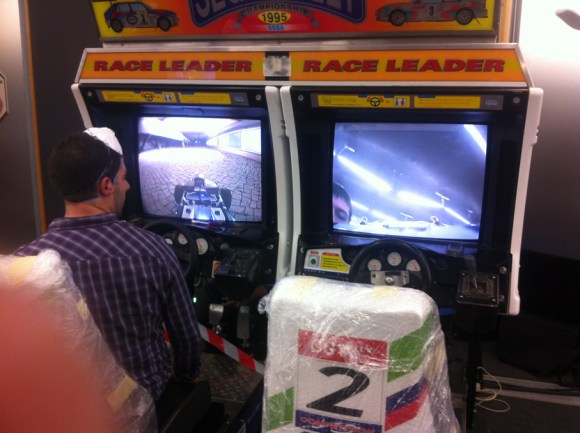
Head to head video game action can’t even compare to this use of a coin-op Sega Rally game to race actual RC vehicles. Take a close look at those screens and you’ll see there are no computer graphics, just a feed for a camera on each of the toy cars.
The project was conceived for the Sapo Codebits VI conference in Portugal. The arcade cabinets had their controls connected to an Arduino, but getting video up and running wasn’t nearly as easy. After fruitless attempts to get the original CRTs to work the team ended up replacing them with functioning CRT units of the same size. The cars themselves have two camera, one on top of the vehicle’s cab and one mounted on a boom for a perspective that was above and behind the vehicle. The drivers can switch between either view. The cars were set loose in the room serving as the event’s retro gaming area and players were free to race each other wherever they pleased. Don’t miss the video clip after the break which shows off all of the fun.
















Reminds me of this great project:
http://www.youtube.com/watch?v=NsfxP77lSu8
This is a great idea!!!
Now, we just wait for them to implement it on a real car….
Top Gear seems to have mastered remote controlled cars quite well.
Excellent build, like the behind-the-car view feature.
Lets strap a camera to a 747 and play flight simulator instead :D
Really? They couldn’t figure out that an arcade monitor – literally, every arcade monitor – simply takes R/G/B plus hsync and vsync at either 15kHz, 24kHz, or 31kHz hsync depending on whether it’s low, medium or high-res? Kids these days…
It doesn’t matter if they could, because the Raspberry Pi itself can’t output “R/G/B plus hsync and vsync at either 15kHz, 24kHz, or 31kHz hsync”. Firstly, it doesn’t have the right physical connector to do so. Secondly, I’m pretty sure the closed source GPU driver on the Pi only allows you to select from a list of standard PC and TV graphics modes, and arcade monitors aren’t on the list. (The much-advertised “open sourcing” of their GPU code actually only open sourced a thin wrapper around the actual, closed source driver which doesn’t really allow you to do anything the previous binary blob couldn’t do.)
I looked at the blog post and it’s not clear whether he was trying to get his 10 other machines to work with the Raspberry Pi or this particular one.
Anyway, despite the lack of detail on the video setup, my guess is that they’re just transmitting composite from cheap cameras off eBay. If this is true, it would make RGB+sync conversion masturbatory at best. I think they made the right decision to just replace the monitors because that goes beyond the scope of the project right now given the likely time constraints and people they had on hand.
If, after the conference, they decide to get the original monitors back in and do a proper conversion so they can switch at will between Sega Rally and their R/C setup, that would amazing! It would be like something out of a James Bond movie.
It would be silly to route the video through the Raspberry Pi. The delay would be horrible. Wifi camera’s make no sense for this application. Video is likely transmitted via RF (or at least should be for realtime). From the description, I’m not even sure why they’re using the RPi at all. Arduino’s and Xbee’s are doing all the work. On the RPi, HDMI is plain evil when it comes to converting to anything analog. With some serious hacking, you could do it with something like an NeTV, but you must have a good understanding of FPGA’s and the HDMI/HDCP protocol. And to get RGB+H/V sync from the composite output means you must use an (obsoleted) IC like the MC44011 or TDA8310A. An old PC would be much more flexible in that regard.
I don’t know if they were using the Raspberry Pi on this project. The person that provided the arcade (“the arcade man”) had other arcades there where at least one of them was converted to use a Raspberry Pi while keeping the original CRT by the end of the event.
The video was RF, I asked.
They need a way to define a finish line for the race, maybe a light sensor on the bottom of each car and an EL wire finish line you can lay down anywhere.